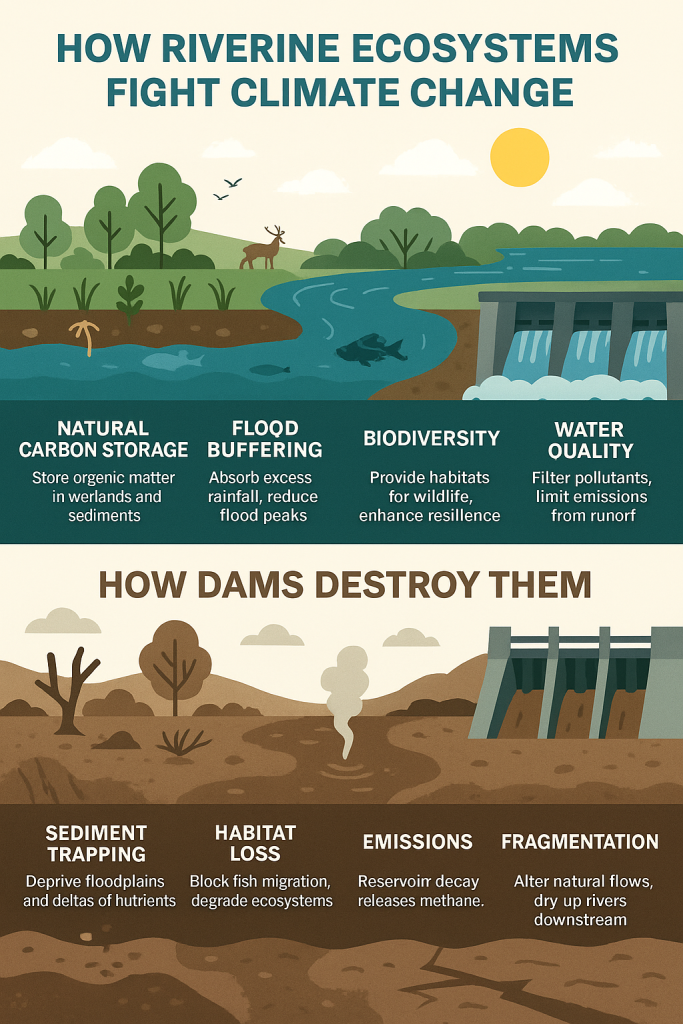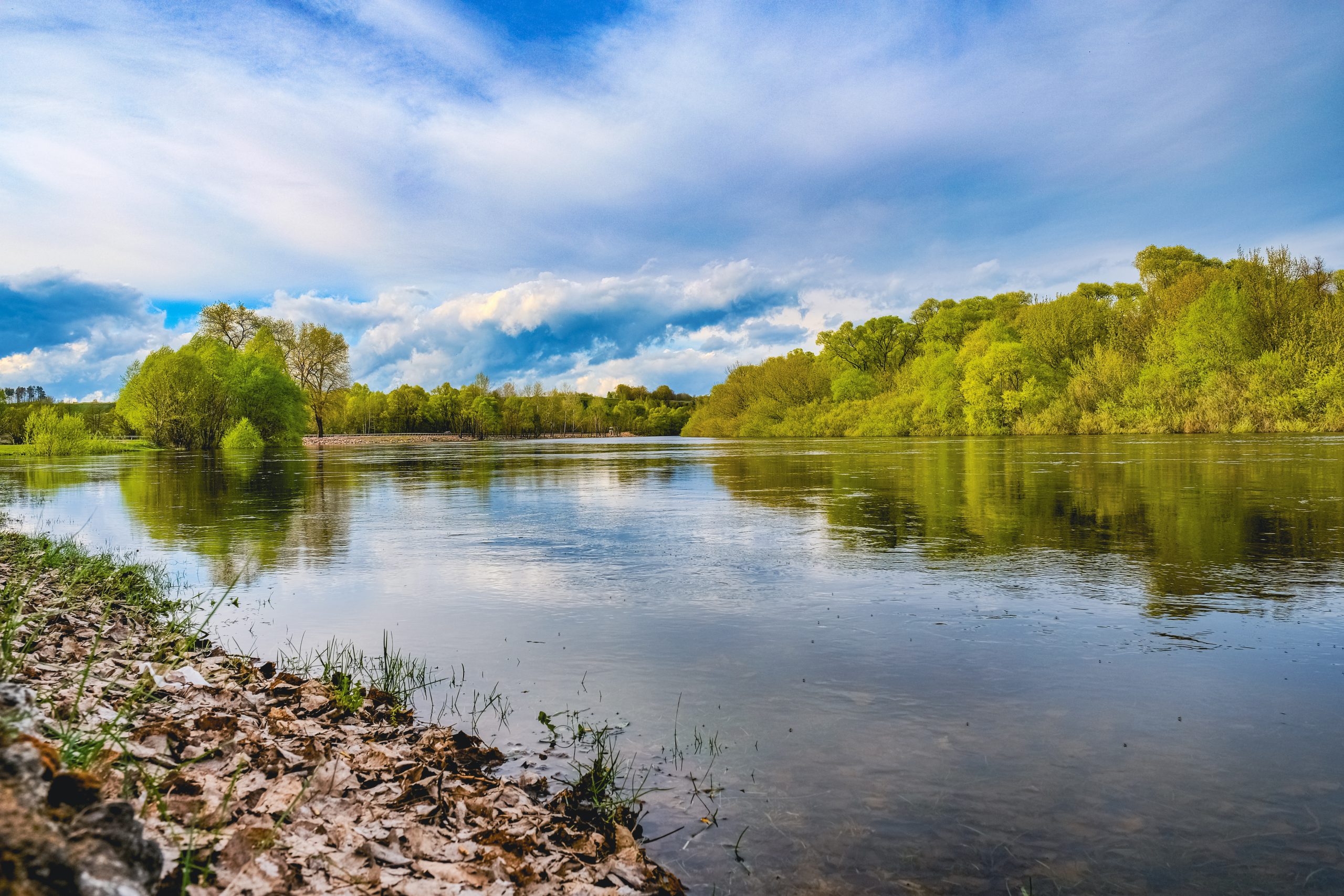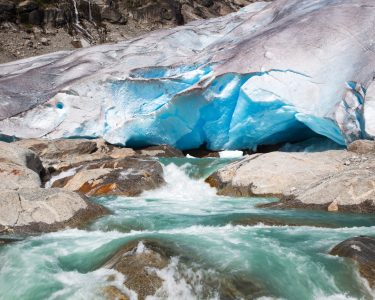Riverine Ecosystems and Climate Change: Lifelines Under Threat from Dams
Riverine Ecosystems and Climate Change: Lifelines Under Threat from Dams
Introduction
When we think of climate change solutions, forests, renewable energy, and cutting carbon emissions often dominate the conversation. Yet, one of nature’s most powerful allies in climate mitigation and adaptation flows quietly through landscapes worldwide: riverine ecosystems. These living systems—rivers, wetlands, floodplains, deltas, and the communities of plants and animals around them—store carbon, regulate floods, recharge aquifers, and sustain biodiversity.
However, these lifelines are under mounting pressure. Across the globe, rivers are dammed, diverted, or degraded. While dams generate hydropower and store water, they also disrupt natural flows, fragment habitats, and weaken riverine ecosystems. In doing so, dams compromise some of our strongest natural defences against climate change.
This article explores the science of ecosystems, the vital role of riverine systems in combating climate change, and the destructive impacts of dams—supported with case studies and lessons for countries like Pakistan.
Understanding Ecosystems
What is an Ecosystem?
An ecosystem is a community of living organisms—plants, animals, microbes—interacting with their non-living environment such as air, water, and soil. Energy flows through ecosystems in food chains, while nutrients cycle between life forms and their surroundings.
Ecosystems can be:
- Terrestrial: Forests, grasslands, deserts.
- Aquatic: Lakes, rivers, wetlands, oceans.
- Human-modified: Agricultural lands, urban green spaces.
Every ecosystem provides ecosystem services—the benefits humans derive from nature. These include:
- Provisioning services (food, water, raw materials).
- Regulating services (climate regulation, flood control, carbon storage).
- Cultural services (spiritual, recreational, aesthetic).
- Supporting services (nutrient cycling, soil formation).

Ecosystem health is therefore not just an environmental concern but a foundation of human survival.
What are Riverine Ecosystems?
Riverine ecosystems are dynamic systems centered around flowing water and its surrounding environments. They include:
- Rivers and streams (channels of flowing water).
- Riparian zones (vegetated areas along riverbanks).
- Floodplains (land areas inundated during seasonal floods).
- Wetlands and deltas (transitional zones where rivers meet larger water bodies).
These ecosystems are interconnected. A river doesn’t just carry water; it transports nutrients, sediments, and energy. Riparian vegetation stabilizes banks, wetlands filter pollutants, and floodplains absorb excess water. Together, they function as living infrastructure—cheaper, more flexible, and more sustainable than any man-made engineering project.
How Riverine Ecosystems Help Avert Climate Change
- Natural Carbon Storage
- Wetlands, floodplains, and delta systems are some of the planet’s largest carbon sinks.
- Organic matter from plants and sediments accumulates in waterlogged soils, locking carbon for centuries.
- Unlike forests, where fires can release carbon back into the atmosphere, wetlands sequester carbon in soils relatively safely.
- Globally, inland wetlands store about 30% of soil carbon despite covering only 6–9% of Earth’s land surface.
Example:
- The Pantanal wetlands (Brazil, Bolivia, Paraguay) store millions of tons of carbon and regulate climate regionally.
The Indus floodplains in Pakistan historically acted as carbon sinks, but encroachment and regulation have reduced their storage capacity

- Flood Regulation and Disaster Risk Reduction
- Floodplains and wetlands act as natural sponges, absorbing heavy rainfall and snowmelt.
- They reduce flood peaks downstream, protecting communities and infrastructure.
- With climate change causing more intense storms and unpredictable rainfall, intact riverine systems are a frontline defence.
Example:
- During the 2022 floods in Pakistan, destruction was worsened because many natural floodplains had been encroached upon or cut off by embankments. Restored wetlands could have absorbed some of the excess water.
- Groundwater Recharge and Water Security
- Seasonal floods replenish groundwater reserves.
- Healthy riverine systems ensure aquifer recharge, critical for agriculture and drinking water in arid and semi-arid regions.
Example:
- In India’s Ganga Basin, traditional floodplain farming and aquifer recharge practices maintained water security for centuries before modern damming altered flows.
- Biodiversity and Climate Resilience
- Rivers support diverse habitats—fish, birds, mammals, amphibians, and plants.
- Biodiversity provides resilience: ecosystems with a variety of species can adapt better to climate shocks.
- Migratory fish, for example, sustain food security and livelihoods across continents.
Example:
- The Mekong River Basin supports the world’s largest inland fishery, feeding over 60 million people. Climate change threatens this system, but intact wetlands and river channels provide resilience.
- Water Quality and Emissions Reduction
- Wetlands filter sediments, nutrients, and pollutants, reducing the need for energy-intensive treatment plants.
- They also limit methane and nitrous oxide emissions from polluted waters by regulating nutrient flows.
Example:
- The Okavango Delta in Botswana, one of the largest inland deltas, naturally purifies water, sustaining both wildlife tourism and human populations without heavy engineering.
How Dams Destroy Riverine Ecosystems
While dams provide electricity, irrigation, and flood control, their ecological costs are immense.
- Altered Flow Regimes
- Dams trap water, altering natural seasonal flows.
- Rivers downstream lose their flood pulses, starving floodplains and wetlands of nutrients and sediments.
Example:
- The Aswan High Dam (Egypt) controlled Nile floods but deprived downstream floodplains of nutrients, reducing soil fertility and altering fisheries.
- Habitat Fragmentation
- Dams block migratory routes of fish and aquatic animals.
- This disrupts breeding cycles, leading to population collapses.
Example:
- The Three Gorges Dam (China) blocked spawning routes for several fish species, pushing some to near extinction.
- Sediment Trapping and Coastal Erosion
- Dams trap sediments that would naturally replenish floodplains and deltas.
- As a result, deltas shrink, coastlines erode, and saltwater intrudes into farmlands.
Example:
- The Indus River Delta (Pakistan), once one of the largest, has shrunk drastically due to upstream dams and barrages trapping sediments. Sea intrusion now destroys agricultural land and mangroves.
- Greenhouse Gas Emissions from Reservoirs
- Decomposing organic matter in reservoirs releases methane, a potent greenhouse gas.
- Some tropical reservoirs emit more greenhouse gases than the fossil fuels the dams were meant to replace.
- Displacement of Communities and Loss of Cultural Ecosystems
- Flooded reservoirs submerge villages, farmland, and heritage sites.
- Communities lose not just land but also cultural and spiritual connections to rivers.
Example:
- The Narmada Dam Project (India) displaced hundreds of thousands of people, destroying traditional river-based livelihoods.
Balancing Development and Ecology: Alternatives to Big Dams
To meet water and energy needs without destroying riverine ecosystems, alternatives include:
- Run-of-river hydropower (smaller projects without massive reservoirs).
- Solar and wind power (reducing reliance on hydropower).
- Ecosystem-based flood management (restoring wetlands and allowing rivers to reconnect with floodplains).
- Sediment bypass systems for existing dams.
Case Studies
- Pakistan’s Indus Basin
- The Indus is one of the world’s most heavily dammed rivers.
- While barrages and dams enabled irrigation for agriculture, they devastated the Indus Delta.
- Today, seawater intrusion, mangrove loss, and fisheries decline highlight the long-term ecological costs.
- Mekong River (Southeast Asia)
- Planned dams threaten to fragment the Mekong, disrupting fish migrations and endangering food security for millions.
- Environmental groups warn that this will undermine climate resilience in one of the world’s most productive basins.
- Colorado River (USA/Mexico)
- Dams and diversions left stretches of the river dry before reaching the sea.
- Recent restoration efforts show promise, but climate change–induced droughts worsen the challenge.
Conclusion
Riverine ecosystems are silent guardians against climate change. They store carbon, buffer floods, recharge aquifers, sustain biodiversity, and purify water. Yet, large dams undermine these functions, fragmenting rivers and degrading the very systems that help us adapt to a warming world.
As nations confront the dual challenges of water scarcity and climate change, the lesson is clear: rivers must be treated as living systems, not just water channels to be engineered. Development must balance human needs with ecological integrity.
For Pakistan and other river-dependent nations, the way forward lies in rethinking dam-centric policies, restoring floodplains, and investing in renewable energy and nature-based solutions. Only then can rivers continue to serve as allies in the fight against climate change.




11 Comments